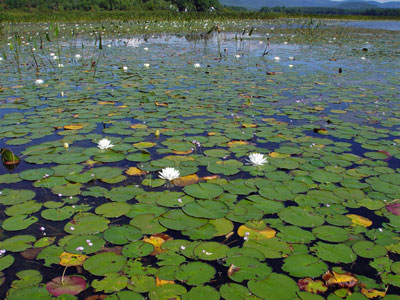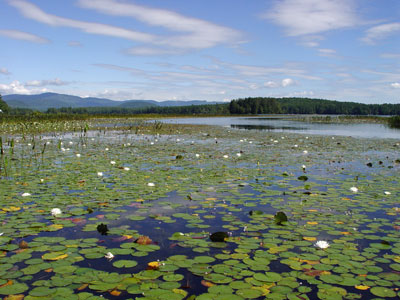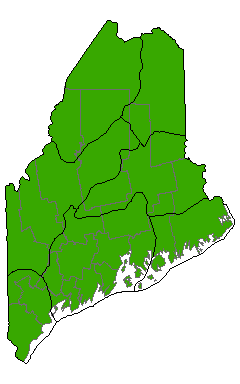DACF Home → Bureaus & Programs → Maine Natural Areas Program → Communities, Plants, and Animals → Natural Community Fact Sheets → Open-water Marsh
Printer Friendly Fact Sheet - 1 MB pdf (Get a free copy of Adobe Acrobat Reader)
Open-water Marsh
Scientific Name: Water-lily - Macrophyte Aquatic Bed; State Rank: S5

- Community Description
- Soil and Site Characteristics
- Diagnostics
- Similar Types
- Conservation, Wildlife and Management Considerations
- Distribution
- Characteristic Plants
- Associated Rare Plants
- Associated Rare Animals
- Examples on Conservation Lands You Can Visit
Community Description: Water-lilies or pondweeds are dominant in this floating aquatic vegetation type. It is currently broadly defined and may be divisible into two or more types with additional data. The strict type has white water-lily, yellow water-lily, or more rarely water-shield as the most abundant species. Variants may lack water-lilies altogether and be dominated by floating leaved pondweed species such as bigleaf pondweed or others. Submerged aquatic plants are also common and may include bladderworts and pipewort. Back to top.
Soil and Site Characteristics: These aquatic beds occur in quiet waters at depths mostly between 0.5 and 2.5 m. The substrate is typically a mixture of silty organic muck. Back to top.

Diagnostics: Water-lily species are prominent (or in variants, pondweed species are prominent); pickerelweed is basically absent. Back to top.
Similar Types: Pickerelweed Marsh and Bulrush Marsh vegetation have greater dominance of emergent versus submerged plants. Sandy Lake - Bottom vegetation has a low cover of floating aquatics and is dominated instead by plants with basal rosettes growing on the bottom. The pondweed variant can be similar to Circumneutral Ponds but lacks the alkaline water indicator species such as water-marigold, common waterweed, Robbins' pondweed, and straight-leaved pondweed. Back to top.
Conservation, Wildlife and Management Considerations: This aquatic community type is widespread and abundant in Maine. It can be found in the quieter portions of streams and rivers as well as in lakes and ponds, and it provides habitat for many water-dependent animals. Many examples occur on public and private conservation lands; however, because the type is so common it is often not documented. The major threats to this natural community are water quality degradation from excess nutrients in runoff and the spread of invasive aquatic plants, such as Eurasian water-milfoil and variable water-milfoil.
In southern and central parts of the state, this community type hosts a number of common reptiles such as northern water snakes, common snapping turtles, and eastern painted turtles. Muskrats, bullfrogs, and green frogs inhabit this community statewide and mink frogs may be found in occurrences from central Maine northward. Northern leopard frogs may utilize these wetlands as breeding grounds. These productive wetlands provide foraging habitat for a number of waterfowl including rare species such as the common moorhen and American coot. Dragonfly and damselfly diversity is typically high in these wetlands and may include species such as the turquoise bluet, little bluet, lilypad forktail, and the rare spatterdock darner. Back to top.
Distribution: Statewide; extending southward and westward from Maine and presumably into Canada Landscape Pattern: Small Patch, often linear along lakeshores. Back to top.


Characteristic Plants: These plants are frequently found in this community type. Those with an asterisk are often diagnostic of this community.
- Herb
- Bayonet rush
- Bigleaf pondweed*
- Pipewort
- Spotted bladderwort*
- Water-shield*
- White water-lily*
- Yellow water-lily*
- American coot
- Common moorhen
- Spatterdock darner
Examples on Conservation Lands You Can Visit
| Example | County |
|---|---|
| Acadia National Park | Hancock Co. |
| Tyler Pond Wildlife Management Area | Kennebec Co. |